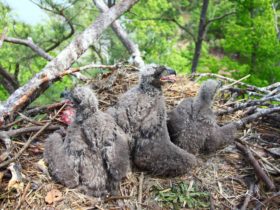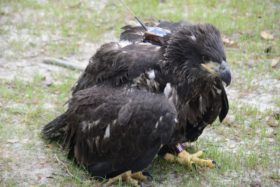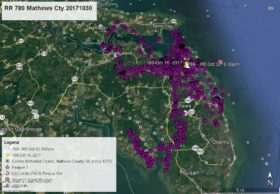NBG Camera Cleaned
Azalea Remains on Middle Peninsula
November 10, 2009Azalea Visits Gloucester County, Etc, Etc, Etc
November 10, 2009
Categories
In preparation for the 2009-10 bald eagle nesting season at Norfolk Botanical Garden, yesterday the camera was cleaned, spiders removed from the inside of the camera housing, a new camera hood installed to keep out the rain. The IR light has to be replaced. It was damaged and full of water. The adult eagles are at the nest early in the morning, but usually leave by 8am and stay gone all day. When they become more active at the nest and after the IR light is replaced, the camera will be reactivated. Can’t give an exact date yet. – Reese




9 Comments
thanks Reese!
Thanks Reese, that is great news!!
How exciting! Thanks for keeping us informed about our girl Azalea and the upcoming nesting season. You are wonderful.
wvec has changed their web site where do we go for eagle cam and falcon cam ? What a dumb idea there was nothing wrong with the old site.WE WANT OUR EAGLE_FALCON CAM!!!
NC Patty – As you have noticed WVEC has a new web page. They have not gotten all of it up and running yet including the Eagle Cam and other live videos.
THE GOOD NEWS IS THAT IT WILL BE BACK SOON AND IT WILL BE BETTER THAN EVER. WVEC HAS MADE IMPROVEMENTS TO THEIR VIDEO STREAMING THAT WILL GIVE A BETTER PICTURE. BE PATIENT. THEY ARE WORKING FOR YOUR BENEFIT AND BETTER VIEWING.
This is great news! I love watching the eagle cam….my family thinks I am a little obsessed with it! LOL.
Glad to hear that WVEC is making it even better. I sincerely appreciate that they have this for us to watch.
Thank you for all the updates. I also love receiving the info on Facebook.
Sorry for the hissey fit.. Patient,I’am not..First thing every morning I check on Azalea,now Barn owl.. also on my favorites Pale male and Lola.Central Park Birds..and the wildlife center in Waynesboro sorry to here they have another juvie eagle with Avain Pox..Hope for the best..O.K. I’am obsessed and hooked on Raptors.. Thank you for the info..
GREAT! Can hardly wait til the eagles get started for this season.. Am so anxious to see, if by chance, Azalea would go back to visit!! Wouldn’t that be wonderful!!
Wow what great news! I arrived late last season (but not too late) so I want to be there from the very beginning. Wish I could be there in person. 🙂